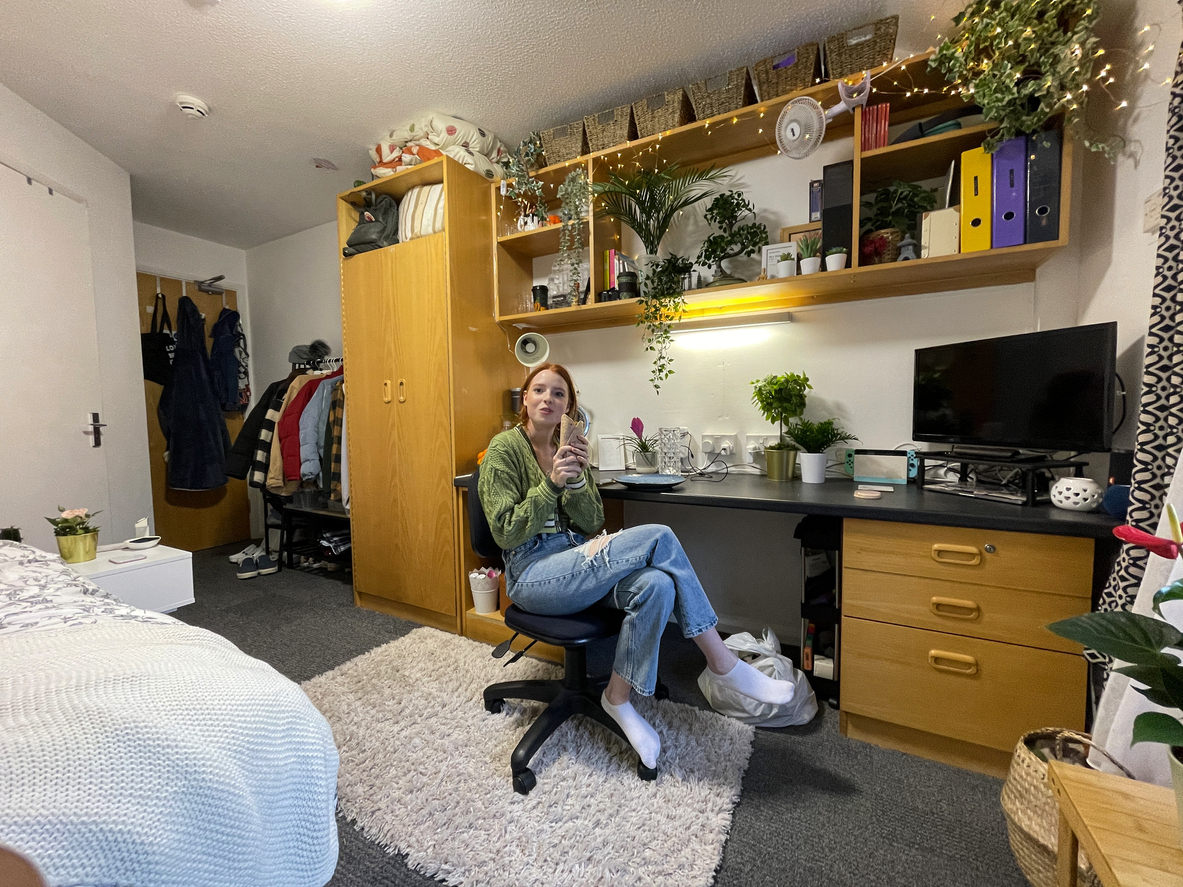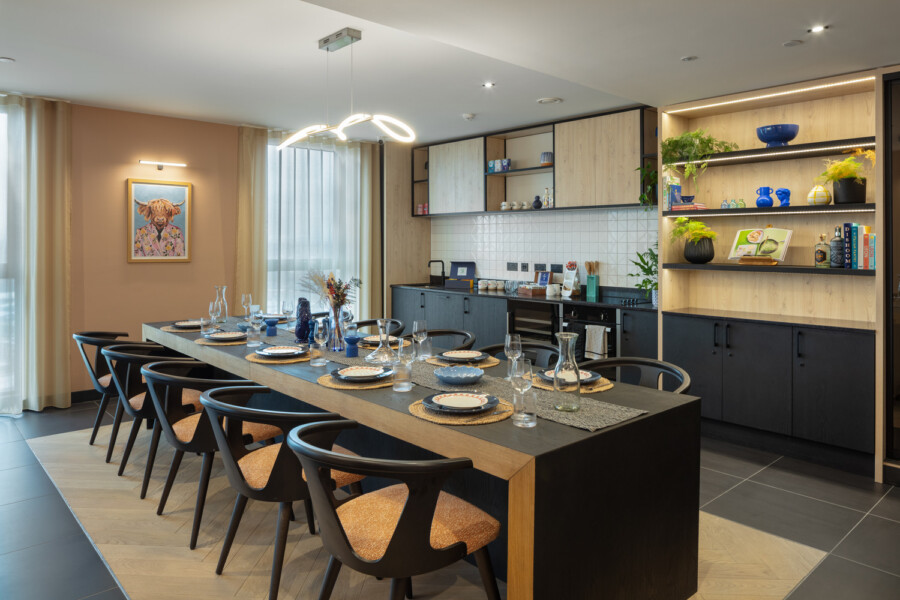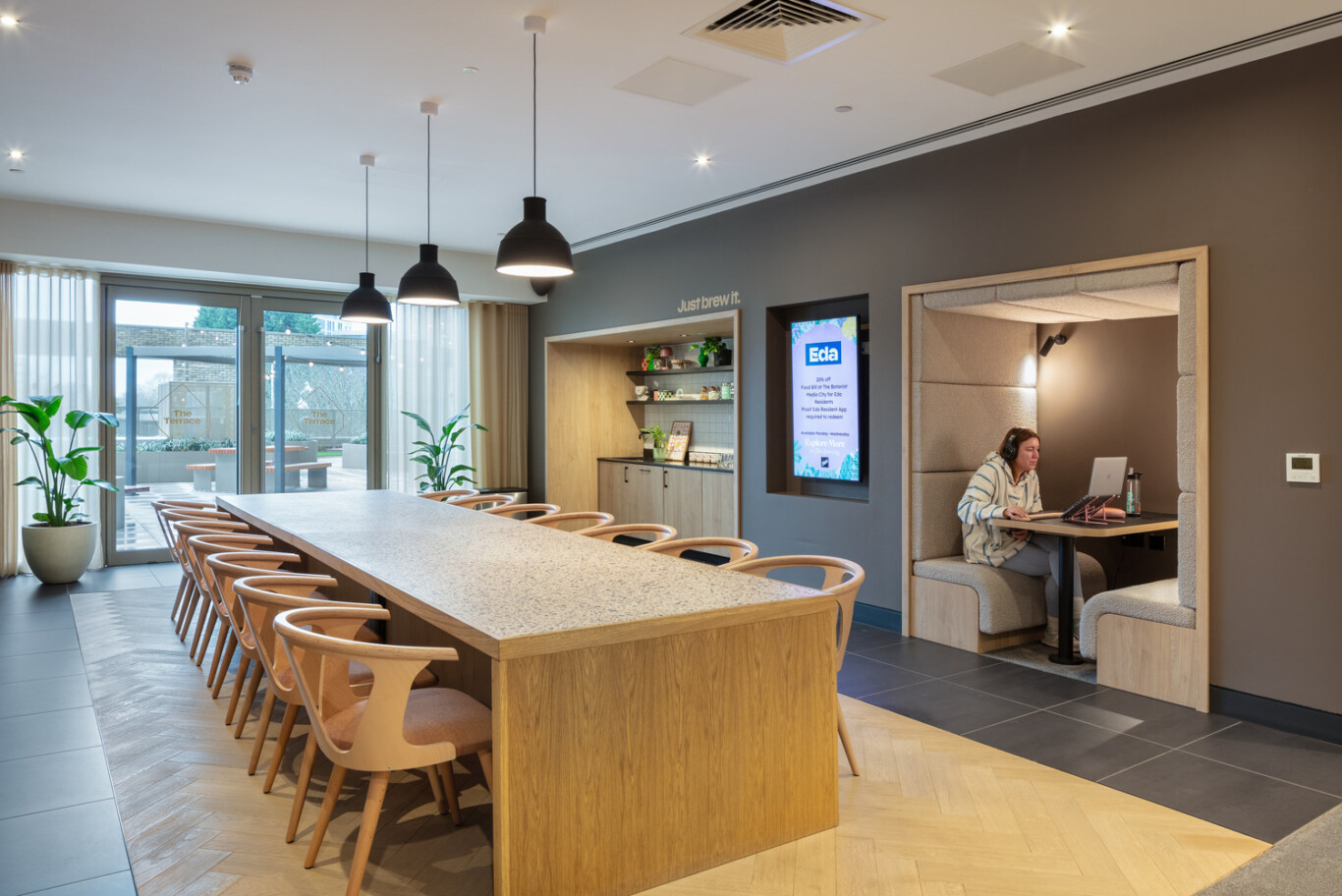
What is Co-living, and how can it help solve the UK Housing Crisis?
Co-living is an emerging sub-sector within the UK residential rental market, characterised by multiple occupiers sharing a space rented from a single owner, often an institutional fund. The product is similar to existing private rental sector (PRS) markets but has some key differences. The concept blends elements of purpose-built student accommodation (PBSA) and the rapidly growing Build-to-Rent (BtR) market, providing a crucial "stepping-stone" for young people transitioning from student life to professional life. When BtR began to establish itself in the UK, it was often described as 'student accommodation for adults'; however, Co-living more aptly occupies this space, sitting somewhere between student living and BtR.
Identifying the gap
There are numerous reasons why there is a demonstrable gap in the residential market, and indeed in the way people choose to live, which is why the emerging Co-living market is gaining so much traction. In broad terms, when facing a chronic housing crisis where undersupply is contributing to a multitude of socio-economic issues, Co-living can and should play an important role. Notwithstanding that PBSA has evolved to provide a varying degree of products and price points, Co-living looks to capitalise on those residents who are not yet financially stable enough to rent on their own or with a small group, offering a more affordable and community-oriented option. In summary, there is a clear price gap which can be filled.
In traditional terms (and for the simplicity of introducing this paper) UK adults often leave their child-home at 18 to attend further or higher education (i.e. University) living within a multiple occupancy property with shared facilities (typically bathrooms, unless provided with ensuites, communal kitchens/cooking facilities and relaxation/lounging spaces).
Whilst some may move into private accommodation with selected friends in subsequent years, often owned by a private landlord (at 'arm's length'), most students will spend their undergraduate years in a form of PBSA. After graduating, usually at 21, they face limited options: return home or rent private accommodation, which is why BtR developments are so popular with students and graduates (multiple students grouping together and splitting the rent can make entry to BtR more affordable). However, because they do not meet the typical quota for young professionals with disposable income and no dependents (i.e. 25-35-year-olds), you will often find that student numbers within BtR properties are 'capped' – typically around 15% of the overall number of apartments. Therefore, residents exiting PBSA are faced with a potential age gap, a working/occupation gap, and an affordability gap (BtR stat here about rental growth to show how unaffordable it is becoming). Co-living fills this gap by providing affordable, shared living spaces with professional management, ensuring continuity in their independent living experience.
Addressing the housing shortage
The UK's housing crisis necessitates diverse and accessible housing typologies to meet the various lifestyles, needs and affordability levels of the general population. The UK has a very broad spectrum when it comes to individual wealth and whilst it grapples to address this on a macro-scale, we must provide housing which responds to this varying demand.
Widening the range of housing types and costs can only be seen as a positive in this regard. This is why we believe Co-living has such an important role to play in the future of our society. Co-living offers a broader range of housing types and price points whilst aiding in professionalising our rental market (which experiences a negative stigma when it comes to rogue landlords). It also provides a lifestyle choice for people who otherwise may have felt forgotten about.
Naturally, it does suit some people more than others. A greater focus on community engagement and shared living (hence the name Co-living) may not immediately be aligned with more introverted personality types. But it can be a more attractive, viable solution for loneliness, or people without their own families or immediate relatives, for single or recently single people and the list goes on. Fundamentally, we don't have an alternative, established offer in the UK, so the introduction of Co-living has the opportunity to benefit many.
Advantages of Co-living
Co-living may also attract some of the 'sharers' within BtR properties, given the leasing structure. The shorter leasing periods offered within Co-living will also appeal to those in early career stages who may not want to commit to long-term leases. It is in this leasing space and tenure approach that Co-living is offering a more inclusive proposition. Typically, Co-living operators are looking to offer shorter lease periods, starting at either 1-month or 3-months and then being open to secure longer tenure just as in the BtR market.
Overcoming Scepticism
Drawing on another parallel with the BtR sector, the emergence of Co-living within the UK has been through a mixture of organic diversification of existing residential products and a highly strategic, targeted move executed by professionals who see the gap in the market and believe in future opportunities. As such, not all the pilot Co-living properties are of the same ilk, and it's not contentious to say that Co-living has been met with significant levels of skepticism from both the industry and the public. However, we have been here before, relatively recently with BtR, where many did not believe that there was such a strong need for this market (which is performing on average around 11% higher than PRS (source of similar statistic?) when it comes to equivalent monthly rental income).
Designing for Co-living
How we design Co-living in the UK will likely develop at pace during its formative years, just as BtR did. However, it can capitalise from lessons learned from the number of 'generations' of BtR design we have already witnessed. The first generation were schemes which were purchased, or forward-funded, by institutional investors but which were not specifically designed with BtR in mind. Similarly, there were developments designed for the open market before being 'converted' to BtR. Today, we are seeing the second wave of specifically designed-for BtR schemes open and become stabilised, schemes which have learnt from the first wave of specific BtR developments as they gather resident and operational feedback. A good case study for this is Eda, which has won numerous awards and maintained an unblemished track record as the top-scoring BtR scheme in the north as voted for by residents (HomeViews citation) – evidence that designing with BtR in mind from the outset can yield significant positive results.
So how does a Co-living scheme differ in design?
Using a simple analogy, Co-living developments blend together the functional design features of PBSA and BtR. For the typical accommodation floors, living, sleeping, and dining spaces are arranged in a cluster format – similar to PBSA but with a focus on enhancing user experience, delivering a more 'mature' product. This translates to clusters of four to five bedrooms, each with an ensuite. As well as access to shared living and dining space (within the 'cluster'), there are larger, development-wide communal spaces which form the general building 'amenity' - similar to BtR developments.
When it comes to the interior design and fit-out of these spaces, expect to see a broad range catering to different price points, driven by the demonstrable market demand. Based on the community spirit of Co-living, amenities are likely to prioritise social connectivity and group gatherings, helping to foster a sense of belonging. Whilst the shorter-term tenancy agreements will naturally mean a greater 'churn' of residents when compared to BtR, the success of these developments will likely depend on how well people engage with their neighbours. Features such as a gym, games room, cinemas and of course multi-functional spaces that can transition between different uses, will naturally encourage social connectivity. However, the rise in popularity of remote-working in the UK will influence amenity space to cater for the 'individual' too, so co-working spaces are likely to feature bookable rooms, meeting rooms and 'phone booth' style pods.
Conclusion
Co-living will undoubtedly be an attractive housing option for young professionals, recent graduates, single individuals, and those new to a city. It strives to engender a sense of community, which could help reduce loneliness and it takes a proactive approach towards facilitating social engagement opportunities. In broader terms, Co-living also presents a viable solution to the housing crisis for young people, offering affordable, community-focused living spaces that bridge the gap between PBSA and BtR. There are also wider societal implications which may result, such as the ability for Co-living to positively impact the national housing crisis by freeing up traditional houses used as HMOs (houses of multiple occupants), potentially returning family-oriented homes to the market. This shift could make 'traditional' housing more affordable and accessible, contributing to a more balanced housing market.
Co-living is an emerging sub-sector within the UK residential rental market, characterised by multiple occupiers sharing a space rented from a single owner, often an institutional fund. The product is similar to existing private rental sector (PRS) markets but has some key differences. The concept blends elements of purpose-built student accommodation (PBSA) and the rapidly growing Build-to-Rent (BtR) market, providing a crucial "stepping-stone" for young people transitioning from student life to professional life. When BtR began to establish itself in the UK, it was often described as 'student accommodation for adults'; however, Co-living more aptly occupies this space, sitting somewhere between student living and BtR.
Identifying the gap
Co-living is an emerging sub-sector within the UK residential rental market, characterised by multiple occupiers sharing a space rented from a single owner, often an institutional fund. The product is similar to existing private rental sector (PRS) markets but has some key differences. The concept blends elements of purpose-built student accommodation (PBSA) and the rapidly growing Build-to-Rent (BtR) market, providing a crucial "stepping-stone" for young people transitioning from student life to professional life. When BtR began to establish itself in the UK, it was often described as 'student accommodation for adults'; however, Co-living more aptly occupies this space, sitting somewhere between student living and BtR.
Identifying the gap
There are numerous reasons why there is a demonstrable gap in the residential market, and indeed, in the way people choose to live, which is why the emerging Co-living market is gaining so much traction. In broad terms, when facing a chronic housing crisis where undersupply is contributing to a multitude of socio-economic issues, Co-living can and should play an important role. Notwithstanding that PBSA has evolved to provide a varying degree of products and price points, Co-living looks to capitalise on those residents who are not yet financially stable enough to rent on their own or with a small group, offering a more affordable and community-oriented option. In summary, there is a clear price gap which can be filled.
In traditional terms (and for the simplicity of introducing this paper) UK adults often leave their child-home at 18 to attend further or higher education (i.e. University) living within a multiple occupancy property with shared facilities (typically bathrooms, unless provided with ensuites, communal kitchens/cooking facilities and relaxation/lounging spaces).
Whilst some may move into private accommodation with selected friends in subsequent years, often owned by a private landlord (at 'arm's length'), most students will spend their undergraduate years in a form of PBSA. After graduating, usually at 21, they face limited options: return home or rent private accommodation, which is why BtR developments are so popular with students and graduates (multiple students grouping together and splitting the rent can make entry to BtR more affordable). However, because they do not meet the typical quota for young professionals with disposable income and no dependents (i.e. 25-35-year-olds), you will often find that student numbers within BtR properties are 'capped' – typically around 15% of the overall number of apartments. Therefore, residents exiting PBSA are faced with a potential age gap, a working/occupation gap, and an affordability gap. Co-living fills this gap by providing affordable, shared living spaces with professional management, ensuring continuity in their independent living experience.
Addressing the housing shortage
The UK's housing crisis necessitates diverse and accessible housing typologies to meet the various lifestyles, needs and affordability levels of the general population. The UK has a very broad spectrum when it comes to individual wealth and whilst it grapples to address this on a macro-scale, we must provide housing which responds to this varying demand.
Widening the range of housing types and costs can only be seen as a positive in this regard. This is why we believe Co-living has such an important role to play in the future of our society. Co-living offers a broader range of housing types and price points whilst aiding in professionalising our rental market (which experiences a negative stigma when it comes to rogue landlords). It also provides a lifestyle choice for people who otherwise may have felt forgotten about.
Naturally, it does suit some people more than others. A greater focus on community engagement and shared living (hence the name Co-living) may not immediately be aligned with more introverted personality types. But it can be a more attractive, viable solution for loneliness, or people without their own families or immediate relatives, for single or recently single people and the list goes on. Fundamentally, we don't have an alternative, established offer in the UK, so the introduction of Co-living has the opportunity to benefit many.
Advantages of Co-living
Co-living may also attract some of the 'sharers' within BtR properties, given the leasing structure. The shorter leasing periods offered within Co-living will also appeal to those in early career stages who may not want to commit to long-term leases. It is in this leasing space and tenure approach that Co-living is offering a more inclusive proposition. Typically, Co-living operators are looking to offer shorter lease periods, starting at either 1-month or 3-months and then being open to secure longer tenure just as in the BtR market.
Overcoming Scepticism
Drawing on another parallel with the BtR sector, the emergence of Co-living within the UK has been through a mixture of organic diversification of existing residential products and a highly strategic, targeted move executed by professionals who see the gap in the market and believe in future opportunities. As such, not all the pilot Co-living properties are of the same ilk, and it's not contentious to say that Co-living has been met with significant levels of scepticism from both the industry and the public. However, we have been here before, relatively recently with BtR, where many did not believe that there was such a strong need for this market.
Designing for Co-living
How we design Co-living in the UK will likely develop at pace during its formative years, just as BtR did. However, it can capitalise from lessons learned from the number of 'generations' of BtR design we have already witnessed. The first generation were schemes which were purchased, or forward-funded, by institutional investors but which were not specifically designed with BtR in mind. Similarly, there were developments designed for the open market before being 'converted' to BtR. Today, we are seeing the second wave of specifically designed-for BtR schemes open and become stabilised, schemes which have learnt from the first wave of specific BtR developments as they gather resident and operational feedback. A good case study for this is Chapman Taylor-designed Eda, which has won numerous awards and maintained an unblemished track record as the top-scoring BtR scheme in the north as voted for by residents – evidence that designing with BtR in mind from the outset can yield significant positive results.
So how does a Co-living scheme differ in design?
The UK's housing crisis necessitates diverse and accessible housing typologies to meet the various lifestyles, needs and affordability levels of the general population. The UK has a very broad spectrum when it comes to individual wealth and whilst it grapples to address this on a macro-scale, we must provide housing which responds to this varying demand.
Widening the range of housing types and costs can only be seen as a positive in this regard. This is why we believe Co-living has such an important role to play in the future of our society. Co-living offers a broader range of housing types and price points whilst aiding in professionalising our rental market (which experiences a negative stigma when it comes to rogue landlords). It also provides a lifestyle choice for people who otherwise may have felt forgotten about.
Naturally, it does suit some people more than others. A greater focus on community engagement and shared living (hence the name Co-living) may not immediately be aligned with more introverted personality types. But it can be a more attractive, viable solution for loneliness, or people without their own families or immediate relatives, for single or recently single people and the list goes on. Fundamentally, we don't have an alternative, established offer in the UK, so the introduction of Co-living has the opportunity to benefit many.
Advantages of Co-living
Co-living may also attract some of the 'sharers' within BtR properties, given the leasing structure. The shorter leasing periods offered within Co-living will also appeal to those in early career stages who may not want to commit to long-term leases. It is in this leasing space and tenure approach that Co-living is offering a more inclusive proposition. Typically, Co-living operators are looking to offer shorter lease periods, starting at either 1-month or 3-months and then being open to secure longer tenure just as in the BtR market.
Overcoming Scepticism
Drawing on another parallel with the BtR sector, the emergence of Co-living within the UK has been through a mixture of organic diversification of existing residential products and a highly strategic, targeted move executed by professionals who see the gap in the market and believe in future opportunities. As such, not all the pilot Co-living properties are of the same ilk, and it's not contentious to say that Co-living has been met with significant levels of scepticism from both the industry and the public. However, we have been here before, relatively recently with BtR, where many did not believe that there was such a strong need for this market.
Designing for Co-living
How we design Co-living in the UK will likely develop at pace during its formative years, just as BtR did. However, it can capitalise from lessons learned from the number of 'generations' of BtR design we have already witnessed. The first generation were schemes which were purchased, or forward-funded, by institutional investors but which were not specifically designed with BtR in mind. Similarly, there were developments designed for the open market before being 'converted' to BtR. Today, we are seeing the second wave of specifically designed-for BtR schemes open and become stabilised, schemes which have learnt from the first wave of specific BtR developments as they gather resident and operational feedback. A good case study for this is Chapman Taylor-designed Eda, which has won numerous awards and maintained an unblemished track record as the top-scoring BtR scheme in the north as voted for by residents – evidence that designing with BtR in mind from the outset can yield significant positive results.
So how does a Co-living scheme differ in design?
Using a simple analogy, Co-living developments blend together the functional design features of PBSA and BtR. For the typical accommodation floors, living, sleeping, and dining spaces are arranged in a cluster format – similar to PBSA but with a focus on enhancing user experience, delivering a more 'mature' product. This translates to clusters of four to five bedrooms, each with an ensuite. As well as access to shared living and dining space (within the 'cluster'), there are larger, development-wide communal spaces which form the general building 'amenity' - similar to BtR developments.
When it comes to the interior design and fit-out of these spaces, expect to see a broad range catering to different price points, driven by the demonstrable market demand. Based on the community spirit of Co-living, amenities are likely to prioritise social connectivity and group gatherings, helping to foster a sense of belonging. Whilst the shorter-term tenancy agreements will naturally mean a greater 'churn' of residents when compared to BtR, the success of these developments will likely depend on how well people engage with their neighbours. Features such as a gym, games room, cinemas, and, of course, multi-functional spaces that can transition between different uses will naturally encourage social connectivity. However, the rise in popularity of remote-working in the UK will influence amenity space to cater for the 'individual' too, so co-working spaces are likely to feature bookable rooms, meeting rooms and 'phone booth' style pods.
Conclusion
Co-living will undoubtedly be an attractive housing option for young professionals, recent graduates, single individuals, and those new to a city. It strives to engender a sense of community, which could help reduce loneliness and it takes a proactive approach towards facilitating social engagement opportunities. In broader terms, Co-living also presents a viable solution to the housing crisis for young people, offering affordable, community-focused living spaces that bridge the gap between PBSA and BtR. There are also wider societal implications which may result, such as the ability for Co-living to positively impact the national housing crisis by freeing up traditional houses used as HMOs (houses of multiple occupants), potentially returning family-oriented homes to the market. This shift could make 'traditional' housing more affordable and accessible, contributing to a more balanced housing market.
Co-living will undoubtedly be an attractive housing option for young professionals, recent graduates, single individuals, and those new to a city. It strives to engender a sense of community, which could help reduce loneliness and it takes a proactive approach towards facilitating social engagement opportunities. In broader terms, Co-living also presents a viable solution to the housing crisis for young people, offering affordable, community-focused living spaces that bridge the gap between PBSA and BtR. There are also wider societal implications which may result, such as the ability for Co-living to positively impact the national housing crisis by freeing up traditional houses used as HMOs (houses of multiple occupants), potentially returning family-oriented homes to the market. This shift could make 'traditional' housing more affordable and accessible, contributing to a more balanced housing market.




